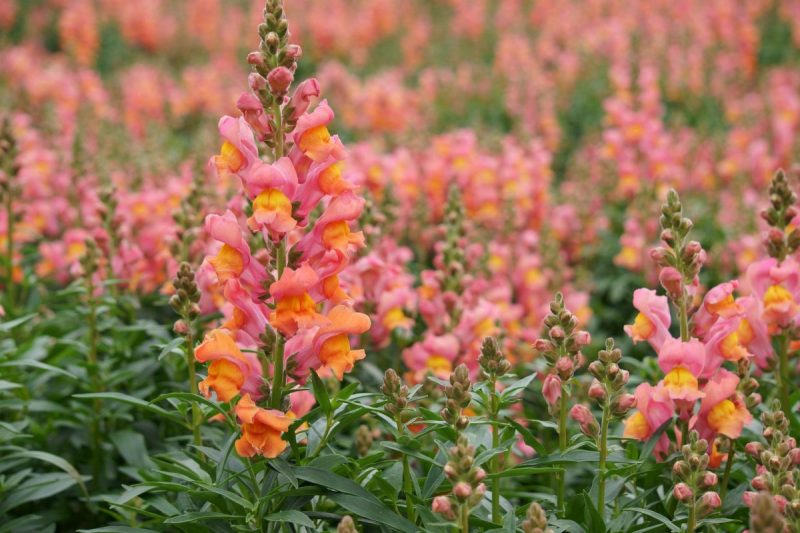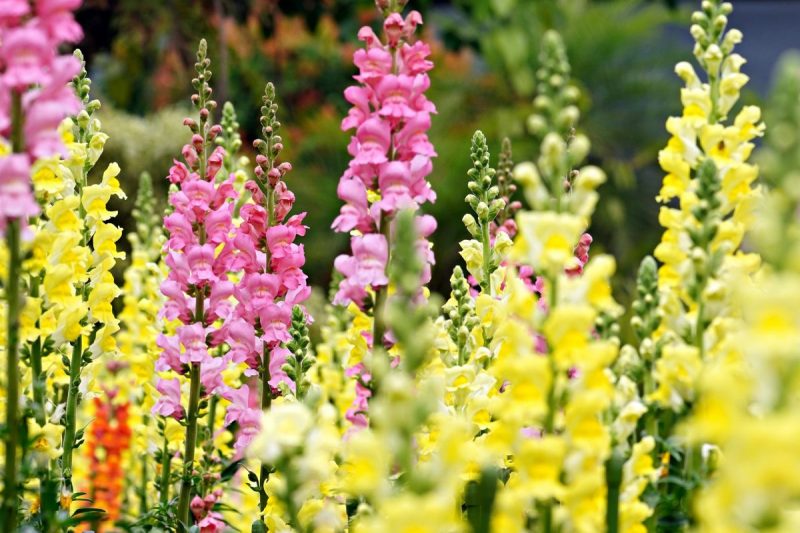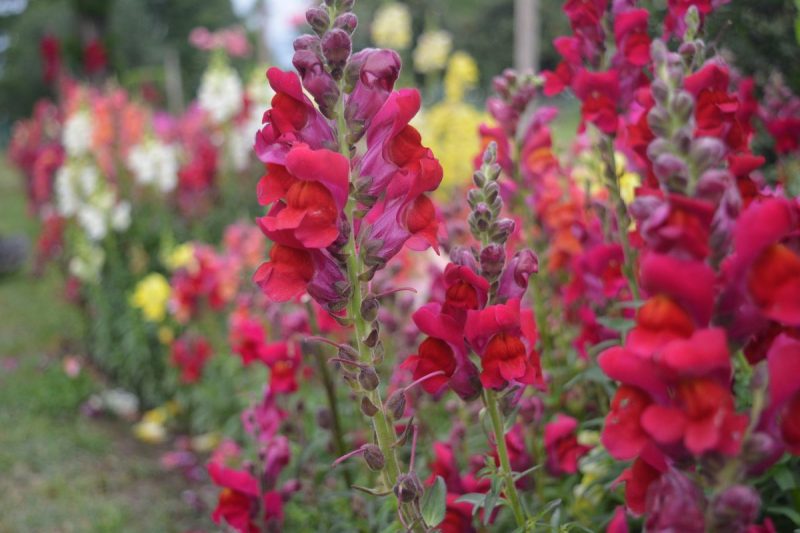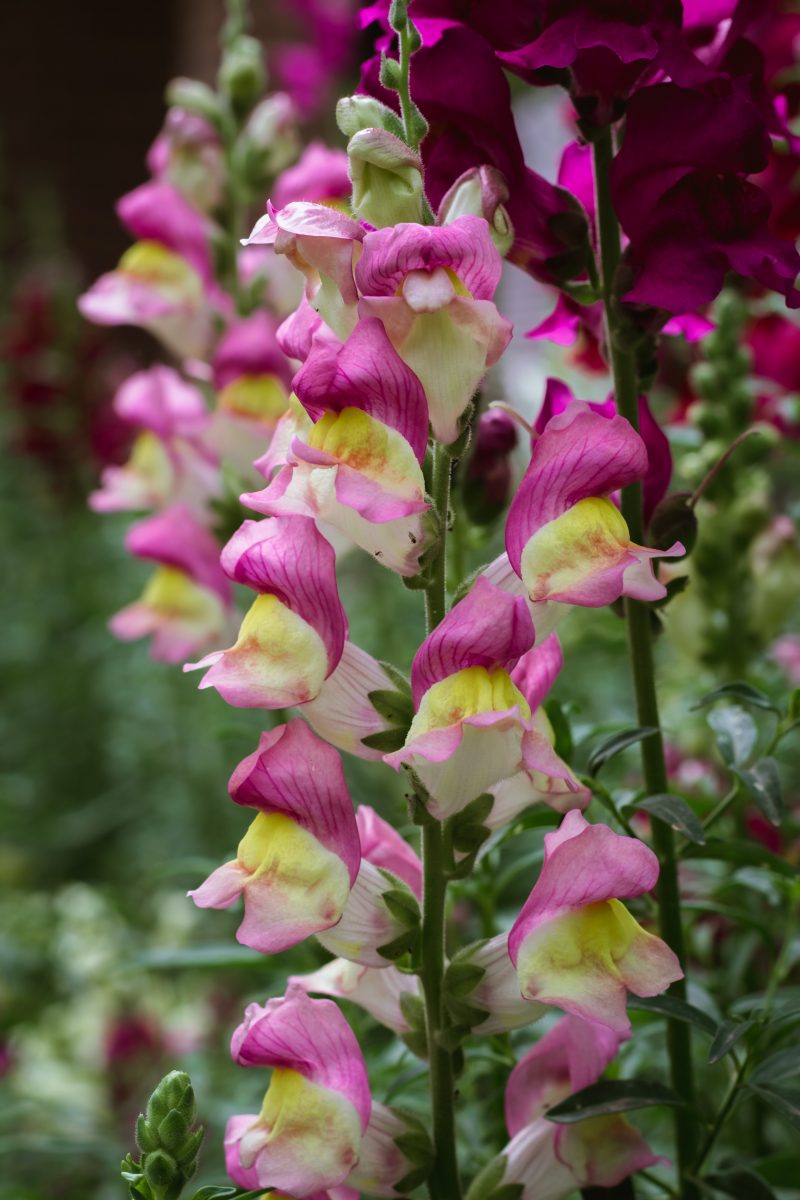Snapdragon, planting guide and care work

Snapdragon (Antirrhinum majus) is a perennial herbaceous plant, often cultivated as an annual plant, which is part of the genus Antirrhinum, being native to Southern Europe, North Africa and America. It is often found in gardens, along curbs, in green spaces or in planters. The leaves are alternately arranged, dark green, petiolate at the base and sessile at the topside.
The flowers are decorative, clustered in raceme inflorescences, found in a wide variety of colors: red, yellow, white, pink, orange, etc. The flowers start to appear from the base of the stem and gradually open upwards, which makes the flowering period longer. These species can bloom throughout the vegetative growth period, but prefer the cooler periods – spring and autumn.
Snapdragon – varieties and cultivars
- ‘Admiral’: this variety includes simple, purple, white, yellow, pink or bicolor flowers that bloom early;
- ‘Black price’: it has intense green leaves and velvety, dark purple flowers, very decorative;
- ‘Bright Butterflies’: a variety with tall plants, having double, variously colored flowers;
- ‘Candy Showers’: it is ideal for hanging baskets and planters. The flowers are double, orange, pink or yellow;
- ‘Lucky lips’: it has very decorative flowers. The petals are white, and in their center there is a red spot.



Environmental conditions
Light. It thrives in light and partial shade conditions. Planting it in partial shade and maintaining an optimal humidity will help the plants get through the hot season.
Temperature. To bloom, it prefers lower temperatures. During the summer, when the temperatures are rising, it is possible that the plants will no longer bloom.
Soil. It grows well on soils with neutral pH, rich in nutrients, that are well drained.
Snapdragon – care
Watering. They are watered regularly immediately after planting, so that the soil remains damp, not too wet. Mature plants are watered moderately, in periods without precipitation, so that the soil slightly dries before watering again. It is important that the watering is carried out as close as possible to the base of the plants, so that the inflorescence and leaves remain dry.
Fertilizing. Fertilizers are recommended when the plants start to form flowers. Balanced fertilizers, specially formulated for flowering plants, can be used.
Recommended products
-
You can find products on a different store
Change Store -
You can find products on a different store
Change Store -
You can find products on a different store
Change Store -
You can find products on a different store
Change Store -
You can find products on a different store
Change Store -
You can find products on a different store
Change Store -
You can find products on a different store
Change Store -
You can find products on a different store
Change Store -
You can find products on a different store
Change Store -
You can find products on a different store
Change Store -
You can find products on a different store
Change Store -
You can find products on a different store
Change Store -
You can find products on a different store
Change Store -
You can find products on a different store
Change Store -
You can find products on a different store
Change Store -
You can find products on a different store
Change Store -
You can find products on a different store
Change Store -
You can find products on a different store
Change Store -
You can find products on a different store
Change Store -
You can find products on a different store
Change Store -
You can find products on a different store
Change Store -
You can find products on a different store
Change Store -
You can find products on a different store
Change Store -
You can find products on a different store
Change Store
Propagation. Snapdragon is frequently propagated by seeds. They can be sown indoors, in hotbeds. The plants will sprout after about 2 weeks and will be transplanted into the garden after the last expected frost in spring. Before planting them outside, the plants need a slight acclimatization. The seeds can be sown directly in the garden, in the spring (after the danger of frost has passed) or in the fall.
Recommended products
-
You can find products on a different store
Change Store -
You can find products on a different store
Change Store -
You can find products on a different store
Change Store -
You can find products on a different store
Change Store -
You can find products on a different store
Change Store -
You can find products on a different store
Change Store -
You can find products on a different store
Change Store -
You can find products on a different store
Change Store -
You can find products on a different store
Change Store -
You can find products on a different store
Change Store -
You can find products on a different store
Change Store -
You can find products on a different store
Change Store -
You can find products on a different store
Change Store -
You can find products on a different store
Change Store -
You can find products on a different store
Change Store -
You can find products on a different store
Change Store -
You can find products on a different store
Change Store -
You can find products on a different store
Change Store -
You can find products on a different store
Change Store -
You can find products on a different store
Change Store -
You can find products on a different store
Change Store -
You can find products on a different store
Change Store -
You can find products on a different store
Change Store -
You can find products on a different store
Change Store
Diseases and pests
The Snapdragon is a plant susceptible to rust, leaf spots, powdery mildew and rot. Among the pests, the most common are mites and aphids.
Recommended products
-
You can find products on a different store
Change Store -
You can find products on a different store
Change Store -
You can find products on a different store
Change Store -
You can find products on a different store
Change Store -
You can find products on a different store
Change Store -
You can find products on a different store
Change Store -
You can find products on a different store
Change Store -
You can find products on a different store
Change Store -
You can find products on a different store
Change Store -
You can find products on a different store
Change Store -
You can find products on a different store
Change Store -
You can find products on a different store
Change Store -
You can find products on a different store
Change Store -
You can find products on a different store
Change Store -
You can find products on a different store
Change Store -
You can find products on a different store
Change Store -
You can find products on a different store
Change Store -
You can find products on a different store
Change Store -
You can find products on a different store
Change Store -
You can find products on a different store
Change Store -
You can find products on a different store
Change Store -
You can find products on a different store
Change Store -
You can find products on a different store
Change Store -
You can find products on a different store
Change Store
Recommended products
-
You can find products on a different store
Change Store -
You can find products on a different store
Change Store -
You can find products on a different store
Change Store -
You can find products on a different store
Change Store -
You can find products on a different store
Change Store -
You can find products on a different store
Change Store -
You can find products on a different store
Change Store -
You can find products on a different store
Change Store -
You can find products on a different store
Change Store -
You can find products on a different store
Change Store -
You can find products on a different store
Change Store -
You can find products on a different store
Change Store -
You can find products on a different store
Change Store -
You can find products on a different store
Change Store -
You can find products on a different store
Change Store -
You can find products on a different store
Change Store -
You can find products on a different store
Change Store -
You can find products on a different store
Change Store -
You can find products on a different store
Change Store -
You can find products on a different store
Change Store -
You can find products on a different store
Change Store -
You can find products on a different store
Change Store -
You can find products on a different store
Change Store -
You can find products on a different store
Change Store
Additionally:
- Since they grow slowly if they are propagated by seeds, they are most often planted directly in the form of seedlings purchased from nurseries;
- They are also used as cut flowers, lasting up to 2 weeks. It is recommended to harvest them when half of the flowers are open.















































































































































































































































































































































































































































